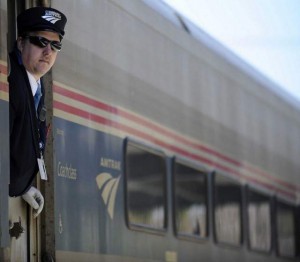From The Detroit News:
 Michigan’s costs for passenger rail service will quadruple this fall under a federal act requiring the state to subsidize its busiest Amtrak route.
Michigan’s costs for passenger rail service will quadruple this fall under a federal act requiring the state to subsidize its busiest Amtrak route.
The 4-year-old law shifts an annual subsidy of about $25 million from the federal government to the state.
Added to the $8 million Michigan provides for its other two Amtrak lines, the state’s tab for passenger rail service will jump to about $33 million.
Tim Hoeffner, director of the Michigan Department of Transportation’s rail office, said the state has little choice but to absorb the added cost if it wants to meet a growing demand for passenger train service in the lower half of the state.
Ridership on the Pontiac-Detroit-Chicago route, Amtrak’s most popular with three daily trains, has risen to nearly a half-million passengers per year. Ridership totaled nearly 800,000 on all three state routes last year, a record.
“I don’t think if we reduced the quality of service we would continue to grow our revenues,” he said. “Our business model is that you have to grow your way to prosperity.”
Under a different philosophy in the late 1990s, the state cut subsidies and reduced service. The result was drops in ridership and revenue that were proportionally greater than the decrease in service, Hoeffner said.
The subsidy shift — atop other federal dictates — irritates House Speaker Jase Bolger, R-Marshall, who will be asked to OK it as part of the state budget.
“I’m so mad at the federal government for its continuation to force our hand, to try to tell us what to do,” Bolger said. “We need to evaluate on our own what’s right for Michigan’s citizens, what’s right for the transportation structure in our state.
“What bothers me about this is the federal government coming in and telling us what to do when they can’t even get their own job done,” said Bolger, referencing spending battles in Congress.
But the state is in the midst of a major financial commitment to improve departure and arrival schedules, travel times and amenities.
In December, Michigan’s Transportation Department signed a deal with Norfolk Southern Railway and the federal government to buy 135 miles of track between Dearborn and Kalamazoo for $140 million.
Work begins in 2014 to upgrade the track so trains will be able to reach speeds as high as 110 miles an hour on that section of what will become high-speed service along the Pontiac-Detroit-Chicago route, which Amtrak calls the Wolverine.
There’s been additional progress on MDOT’s high-speed rail project: Trains have been able to run at 110 mph for almost a year on 80 miles of the 100-mile portion of the Wolverine route between Kalamazoo and the Burns Harbor area of Indiana.
It’s the first stretch of rail outside the northeastern U.S. rail corridor to see that speed, Hoeffner said.
“We’ll raise the speed as much as we can in as many places as we can along the route,” he said.
Hoeffner said the state’s higher tab to subsidize Amtrak will be included in the 2013-14 fiscal year spending plan Gov. Rick Snyder presents to the Legislature Feb. 7. The new state budget takes effect Oct. 1.
MDOT officials knew this was coming. It’s mandated by the Passenger Rail Investment and Improvement Act of 2008, which shifts Amtrak subsidies from the federal government to the states on routes shorter than 750 miles. The Wolverine route is 283 miles long.
There is a trade-off: The federal act also awards millions of federal dollars to Michigan to cover the full cost of new passenger cars Amtrak will start running on the state’s lines in three to four years.
Most Amtrak routes are subsidized because ticket revenues fall short of costs.
In Michigan, the state has been subsidizing two routes, the Blue Water and the Pere Marquette. Until now, the feds had provided the subsidy for the Wolverine.
Besides setting a new ridership high in Michigan in 2012, Amtrak took in a record $29 million. The official ridership figures for the year: The Blue Water route, once daily between Port Huron, East Lansing and Chicago, 187,991 passengers. The Pere Marquette, once a day between Grand Rapids and Chicago, 109,501. The Wolverine had 495,277 riders.
From The Detroit News: http://www.detroitnews.com/article/20130126/METRO/301260353#ixzz2JQjaxH8O
